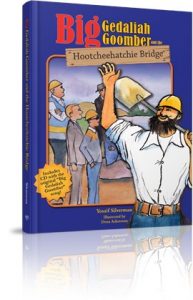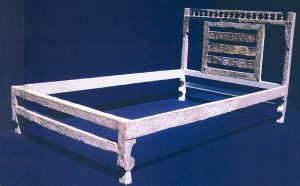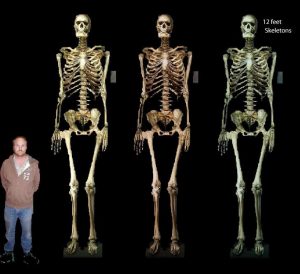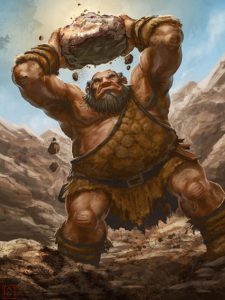Methuselah (Misushelach) vs. Oig: who lived longer?
Oig vs. Big Gedalya Goomber: who was taller?
Though we all grew up believing that Misushelech (Methuselah) who lived 969 years was the record holder for age, this week, we will meet a fellow by the name of Oig Melech Haboshon (Oig, the King of Bashan), and if any of the midroshim that wax fancy about him are emes, he may have outlived Methuselah by hundreds of years. And lest you think that most Jewish men were, or are, 5′ 10″ tall or less, a shtikel Gemora on this week’s parsha will tell us that Moishe was ten cubits, or about fifteen feet tall. Ober, what about Oig? Was he perhaps -though not Jewish- perhaps the tallest man to ever have lived? We shall address that below, ober ershtens…
Decades back, when the future Oisvorfer was quite young, he and his friends would spontaneously begin singing “I’m big Gidalya Goomber..,” a song about a giant who wouldn’t work on the heylige shabbis. The song, composed and originally recorded by Rabbi Yosaif Silverman in 1963, still pops into his head from time to time and especially so when reminiscing with chaverim about the good old days. Mention ‘Big Gidalya Goomber’ to anyone over 50 and they’ll quickly break out into song. Long forgotten by today’s generation, ober with thanks to the heylige internet, and specifically to Rav Google, here is a link to the words. And if you want to hear it, click here.
Growing up many believed that the mythical Gidalya Goomber was the tallest man who ever lived. In the song, he measures in at 17 feet. Ober was he? And why are we discussing Gidalya Goomber? Is he related to this week’s parsha of Chukas, known mostly for the strange and indecipherable laws concerning the purification of a person who had become defiled from contact with a corpse, through the ashes of what was a red heifer? Nu, we shall explore Gidalya’s connection mamish below, ober for those who want to get depressed while reading how and why the RBSO decided to cancel the passports of Miriam, Aharoin and even Moishe, the triumvirate who led the Yiddin out of Mitzrayim, and throughout their 40 year sojourn in the Midbar, feel free to read the parsha, or, visit the archives at www.oisvorfer.com where you can read mamish amazing reviews on this parsha. Each mamish a gem.
 Lommer unfangin (let’s begin). It’s year 40 since redemption, and the Yiddin, those chosen to live following various calamites that wiped out all the males (excepting those from Sheyvet Levi) between twenty and fifty, including Aharoin, Miriam and soon to come, even Moishe -some say Miriam was the only woman to die in the midbar- and the Yiddin are finally on their march towards the Promised Land. To get there, they will be warring with several nations, capturing land, and all else. With the RBSO on their side, they were schmeising their enemies. And mamish towards the very end of the parsha -the very pisukim you rarely get to read, hear or learn because you are already in the hallway, in the kiddish room, or chas v’sholom -say it’s not so- efsher outside the building schmoozing and speaking loshoin horo- we encounter these very interesting and telling pisukim. Says the heylige Toirah (Bamidbar: 21:33-35) azoy:
Lommer unfangin (let’s begin). It’s year 40 since redemption, and the Yiddin, those chosen to live following various calamites that wiped out all the males (excepting those from Sheyvet Levi) between twenty and fifty, including Aharoin, Miriam and soon to come, even Moishe -some say Miriam was the only woman to die in the midbar- and the Yiddin are finally on their march towards the Promised Land. To get there, they will be warring with several nations, capturing land, and all else. With the RBSO on their side, they were schmeising their enemies. And mamish towards the very end of the parsha -the very pisukim you rarely get to read, hear or learn because you are already in the hallway, in the kiddish room, or chas v’sholom -say it’s not so- efsher outside the building schmoozing and speaking loshoin horo- we encounter these very interesting and telling pisukim. Says the heylige Toirah (Bamidbar: 21:33-35) azoy:
| 33 Then they turned and headed north toward the Bashan. Og, the king of Bashan, came out toward them with all his people, to wage war at Edrei. | לגוַיִּפְנוּ֙ וַיַּֽעֲל֔וּ דֶּ֖רֶךְ הַבָּשָׁ֑ן וַיֵּצֵ֣א עוֹג֩ מֶֽלֶךְ־הַבָּשָׁ֨ן לִקְרָאתָ֜ם ה֧וּא וְכָל־עַמּ֛וֹ לַמִּלְחָמָ֖ה אֶדְרֶֽעִי: | |
| 34 The Lord said to Moses, “Do not fear him, for I have delivered him, his people, and his land into your hand. You shall do to him as you did to Sihon the king of the Amorites who dwells in Heshbon. | לדוַיֹּ֨אמֶר יְהֹוָ֤ה אֶל־משֶׁה֙ אַל־תִּירָ֣א אֹת֔וֹ כִּ֣י בְיָֽדְךָ֞ נָתַ֧תִּי אֹת֛וֹ וְאֶת־כָּל־עַמּ֖וֹ וְאֶת־אַרְצ֑וֹ וְעָשִׂ֣יתָ לּ֔וֹ כַּֽאֲשֶׁ֣ר עָשִׂ֗יתָ לְסִיחֹן֙ מֶ֣לֶךְ הָֽאֱמֹרִ֔י אֲשֶׁ֥ר יוֹשֵׁ֖ב בְּחֶשְׁבּֽוֹן: | |
| 35 They smote him, his sons and all his people, until there was no survivor, and they took possession of his land. | להוַיַּכּ֨וּ אֹת֤וֹ וְאֶת־בָּנָיו֙ וְאֶת־כָּל־עַמּ֔וֹ עַד־בִּלְתִּ֥י הִשְׁאִֽיר־ל֖וֹ שָׂרִ֑יד וַיִּֽירְשׁ֖וּ אֶת־אַרְצֽוֹ: |
Who the hec is this Oig fellow? Is this his first appearance in the heylige Toirah? Yes and no! He is not found anywhere in the earlier writings and we won’t hear his name again until Parshas Devorim (just over a month from now) and where he gets several shout-outs -eight to be exact- by name. Ober, anyone who went to yeshiva avada heard the name Oig Melech Haboshon (Oig the king of Bashan). He captured our imagination. Who was he? Where did we hear and read about him? Let’s find out! Every rebbe of every class taught his students that Oig was a giant of a man and the only person -aside from Noiach and his family- to have survived the Mabul (the flood). He did? Why was this little factoid not mentioned in the heylige Toirah? Ver veyst? How did he survive? Was he in the teyvo (ark)? WARNING: what you’re about to read is not found anywhere in the heylige Toirah. It is however found in a few Rashis, various medroshim and in the heylige Gemora. Together, and with mamish healthy doses of creativity and imagination, they spun together his story and resume. Here it is.
Let’s hearken back to parshas Bereishis and let’s read pisukim 1-4 in perek 6.
| 1.And it came to pass when man commenced to multiply upon the face of the earth, and daughters were born to them. | אוַיְהִי כִּי הֵחֵל הָאָדָם לָרֹב עַל פְּנֵי הָאֲדָמָה וּבָנוֹת יֻלְּדוּ לָהֶם: | |
| 2. That the sons of the nobles saw the daughters of man when they were beautifying themselves, and they took for themselves wives from whomever they chose. | בוַיִּרְאוּ בְנֵי הָאֱלֹהִים אֶת בְּנוֹת הָאָדָם כִּי טֹבֹת הֵנָּה וַיִּקְחוּ לָהֶם נָשִׁים מִכֹּל אֲשֶׁר בָּחָרוּ: | |
| 3. And the Lord said, “Let My spirit not quarrel forever concerning man, because he is also flesh, and his days shall be a hundred and twenty years.” | גוַיֹּאמֶר יְהֹוָה לֹא יָדוֹן רוּחִי בָאָדָם לְעֹלָם בְּשַׁגָּם הוּא בָשָׂר וְהָיוּ יָמָיו מֵאָה וְעֶשְׂרִים שָׁנָה: | |
| 4. The Nephilim were on the earth in those days, and also afterward, when the sons of the nobles would come to the daughters of man, and they would bear for them; they are the mighty men, who were of old, the men of renown. | דהַנְּפִלִים הָיוּ בָאָרֶץ בַּיָּמִים הָהֵם וְגַם אַחֲרֵי כֵן אֲשֶׁר יָבֹאוּ בְּנֵי הָאֱלֹהִים אֶל בְּנוֹת הָאָדָם וְיָלְדוּ לָהֶם הֵמָּה הַגִּבֹּרִים אֲשֶׁר מֵעוֹלָם אַנְשֵׁי הַשֵּׁם: |
The heylige Toirah tells us that the Niphilim were then on the earth. The Niphilim had either fallen down from heaven or descended to earth. Why? Some say that two malochim (angels) in a discussion with the RBSO, had told Him they could withstand earthly temptations and live sin free, as do the angels up in heaven. Shemhazai was one of these rebellious angels. In any event, the medrish will teach us that Oig may have been a grandson of the malach (angel) Shemhazai. Seemingly they came down with earthly bodies. Nu, with earthly bodies they quickly behaved as do humans; very soon thereafter, they were involved in chazerish behavior; they were bedding -as stated in posik 3 above- many women, with and without consent. Yikes! Their offspring were known as the Niphilim, the giants that are described in posik 4. The bottom line: Oig was seemingly from a family that started off as half angel and half human; perhaps that would account for his unusual height? How tall was he? Nu, that depends on how we interpret the words of the heylige Toirah as found in parshas Devorim and which tells us azoy: His bed was made of iron. Why iron? Seemingly the wood could not support his frame. “….Nine cubits was its length and four cubits its breadth, according to the cubit of the man. How large is a cubit? That depends on whom you ask, ober according to all, Oig was very very tall. Some say he was just shorter than his bed which was nine cubits long, others say he was much taller. In height, some have him at only 9 plus feet, others at over 18 feet tall. Certainly, he was over 5′ 10”, and it appears that he was at least a foot taller than Big Gidalya Goomber.
 The bottom line: if this account holds water -and isn’t every medrish 100% emes- (don’t answer that), then Oig was born a few hundred years before Noiach. And when was Noiach born? In the year 1056. Let’s also keep in mind that Noiach was 600 years old at the time of the mabul (flood) in the year 1656. And while we don’t have an exact birthday for Oig, given that Parshas Bereishis is mostly if not totally chronological, again we assume, but cannot confirm, that he was indeed born a few hundred years before Noiach. If Noiach was 600 at the time for the flood, we believe that Oig was at least 100-200 years older, making him 800-900 years old back in 1656. It’s of course possible and logical to believe that Oig was more than 200 years older than was Noiach ober let’s go veyter. Let’s also take note that Parshas Chukas takes place in the year 2448 and using simple math, we figure that Oig was at least 1400 years old before he was killed at the very end of our parsha. 1400+ years is certainly more than the 969 years that Misushelach lived and case closed.
The bottom line: if this account holds water -and isn’t every medrish 100% emes- (don’t answer that), then Oig was born a few hundred years before Noiach. And when was Noiach born? In the year 1056. Let’s also keep in mind that Noiach was 600 years old at the time of the mabul (flood) in the year 1656. And while we don’t have an exact birthday for Oig, given that Parshas Bereishis is mostly if not totally chronological, again we assume, but cannot confirm, that he was indeed born a few hundred years before Noiach. If Noiach was 600 at the time for the flood, we believe that Oig was at least 100-200 years older, making him 800-900 years old back in 1656. It’s of course possible and logical to believe that Oig was more than 200 years older than was Noiach ober let’s go veyter. Let’s also take note that Parshas Chukas takes place in the year 2448 and using simple math, we figure that Oig was at least 1400 years old before he was killed at the very end of our parsha. 1400+ years is certainly more than the 969 years that Misushelach lived and case closed.
Ober where was he and what was he doing with his time? Nu, following the flood which wiped out humanity and the animal kingdom (some say the fish who were well behaved and did not have sexual relations outside their own species, were also spared), the heylige Toirah tells us that only Noiach, his family, and the animals he brought along, survived. Says the heylige Toirah (Bereishis 7:23): azoy:
| 23. And it [the Flood] blotted out all beings that were upon the face of the earth, from man to animal to creeping thing and to the fowl of the heavens, and they were blotted out from the earth, and only Noah and those with him in the ark survived. | כגוַיִּמַח אֶת כָּל הַיְקוּם | אֲשֶׁר | עַל פְּנֵי הָאֲדָמָה מֵאָדָם עַד בְּהֵמָה עַד רֶמֶשׂ וְעַד עוֹף הַשָּׁמַיִם וַיִּמָּחוּ מִן הָאָרֶץ וַיִּשָּׁאֶר אַךְ נֹחַ וַאֲשֶׁר אִתּוֹ בַּתֵּבָה: |
Note, the heylige Toirah is empathic: only Noiach and his family survived. And if Oig predates Noiach and was alive during his times, how the hec did he survive? Nu, let’s see how this question is addressed. From the two Hebrew words “Ach Noiach” whose letters, when added up in gematria language (the total of the numerical value of each Hebrew letter), we come to the number 79. And guess what? The word Oig, when spelled in Hebrew (ayin+ vov + gimmel), and when looked at through gematria (by adding 70 for the ayin, 6 for the vov, and 3 for the gimmel), also come to 79? Shoin, and guess what? Says the medrish (Pirkei D’ Rebee Eliezer 23): 79 = 79 and guess what? Oig also survived the mabul! Was he a stowaway? Not! Of course not! If Oig was taka a giant, mistama, he could not fit into the teyvo and certainly without going unnoticed and unmentioned. Where was he? Says the medrish: Oig, not yet king of Boshon, survived the flood by hitching a ride on the outside of the teyvo. How? Says the medrish (Yalkut Shimoni): Sensing danger, Oig, seemingly promised Noiach that if allowed to ride out the storm, he would become Noiach’s slave or servant for life. Noiach agreed! Noiach then either added a plank which was attached to the back of the teyvo, or cut a hole somewhere, and Oig survived the mabul. Ober how would Oig survive the waters which -as we were taught- were so hot -think molten lava- they wiped out anything alive? Not to worry. Why not? Says the heylige Gemora (Zivochim 113b), azoy: the RBSO performed yet another miracle: though the waters of the mabul were taka scolding hot, the waters immediately surrounding the teyvo were cool to the touch; Oig survived and was not at all hurt. Givaldig? Wait: it gets better, much, and by the time you read of Oig’s exploits, pre and post mabul, you will zicher want to run out and buy every medrish ever printed. Efsher you’re wondering what Oig ate or drank for forty days and nights? As a giant, certainly he needed some nourishment. Did he channel the jolly green giant and survive on a few cans of corn? Not! Seemingly Noiach, built a trap door which he accessed when needed, and fed Oig throughout the excursion. Oig survived the mabul.
What happened next: Says the heylige Zoihar and who knew more than him, azoy: Oig kept his promise. He went on to serve Noiach and his descendants. Moreover, Oig somehow wound up as one of the servants in the Avrom Ovenu household. The Zoihar also tells us that Oig, as a member in good standing of the Avrom household, also underwent circumcision on his own member. And with that information, let’s move onto parshas Lech Lecha where we read about Oig’s next appearance. Again, he is not mentioned by name, ober, Rashi quoting a few other medroshim, fills us in as to the identity of ‘the stranger’ who suddenly appeared in Avrom’s tent with breaking and critically important news. While Avrom was home relaxing with his wife Sorai (both names later changed to Avrohom and Soro), a fellow came in and told Avrom that his nephew Loit had been taken captive. Let’s read the posik (Bereishis 14:13) innaveynig:
| 13. And the fugitive came and he told Abram the Hebrew, and he was living in the plain of Mamre the Amorite, the brother of Eshkol and the brother of Aner, who were Abram’s confederates. | יגוַיָּבֹא הַפָּלִיט וַיַּגֵּד לְאַבְרָם הָעִבְרִי וְהוּא שֹׁכֵן בְּאֵלֹנֵי מַמְרֵא הָאֱמֹרִי אֲחִי אֶשְׁכֹּל וַאֲחִי עָנֵר וְהֵם בַּעֲלֵי בְרִית אַבְרָם: |
Says the medrish: while there, the fellow (Oig) laid eyes on Sorai, noticed her beauty, and kept that in mind. Actually he concocted a plan but let’s file that away for a moment. Says Rashi: the unnamed person was Oig who was the lone survivor of his tribe, the Rephaim, and or from the mabul. Seemingly his tribesmen were all killed during the long drawn out war between the four and five kings. What about Sorai’s beauty? Rashi tells us that when Oig laid eyes upon Sorai, he wanted her for himself. But she had something that could knock his eyes out: a husband! What to do? As he reported the news that Loit was taken captive, Oig was secretly hoping that Avrom would of course give chase and try to free his nephew. In Oig’s plan, Avrom would be killed during the pursuit and he, Oig, would then come back and marry Sorai. The RBSO took note of Oig’s chazerishe plan and filed it away. That file is opened and reviewed in this week’s parsha as Oig will be killed by Moishe. More on that below. Seemingly, the RBSO has a long memory; yikes!
 As an aside, though Oig may have been the first to lay eyes on a married woman and secretly hope for her husband’s demise on the war front, he was zicher not the last Toirah character with a plan. Let’s not forget that Dovid Hamelech (King David) too concocted a plan to get rid of a husband, ober that for another time and place. In any event, we hear anything more about Oig from parshas Lech Lecha which takes place during the lifetime of Avrom who was born in the year 1948 from Creation (circa 1800 BCE) and died 175 years later, until this week, Parshas Chukas, our parsha of the week, where we read about Oig by name for the very first time and how Moishe killed him during the war effort.
As an aside, though Oig may have been the first to lay eyes on a married woman and secretly hope for her husband’s demise on the war front, he was zicher not the last Toirah character with a plan. Let’s not forget that Dovid Hamelech (King David) too concocted a plan to get rid of a husband, ober that for another time and place. In any event, we hear anything more about Oig from parshas Lech Lecha which takes place during the lifetime of Avrom who was born in the year 1948 from Creation (circa 1800 BCE) and died 175 years later, until this week, Parshas Chukas, our parsha of the week, where we read about Oig by name for the very first time and how Moishe killed him during the war effort.
How did Moishe go about killing this giant of a man. The heylige Gemora (Birochis 54b) provided the following: “How tall was Moishe? Ten Amos. He took an axe that was ten amos long. He then jumped ten amos upwards and smote Oig on his ankle and killed him.” Based on this Gemora, Oig was quite the imposing figure. When we review Parshas Devorim, we will further explore why Moishe, had some fear about warring with Oig the giant. Stay tuned.
A gittin Shabbis!
The Heylige Oisvorfer Ruv
Yitz Grossman


